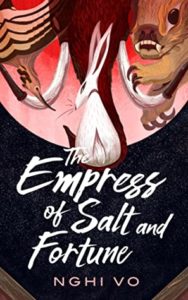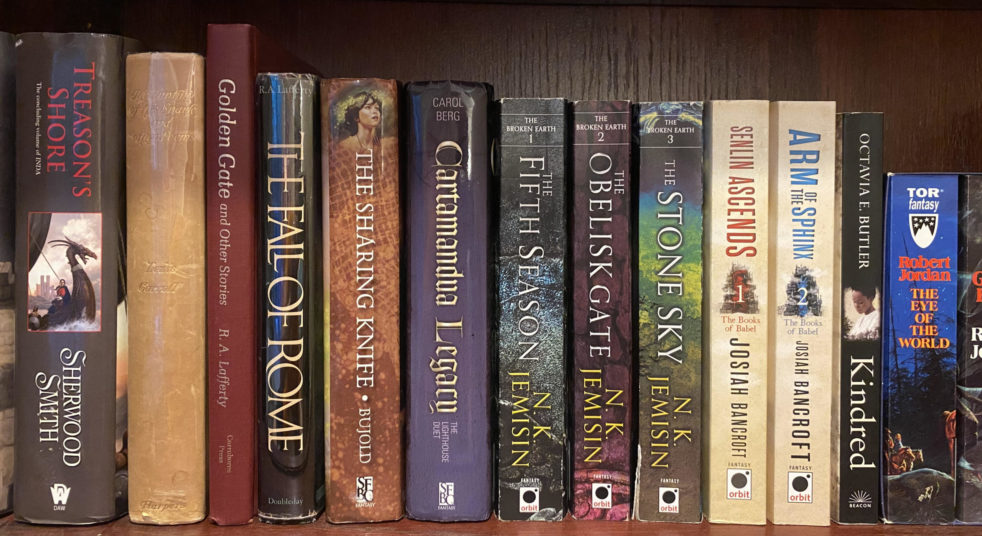
I’d heard quite a bit about Nghi Vo’s debut novella The Empress of Salt and Fortune when it came out last year, but it didn’t distinguish itself from an overstuffed TBR until it appeared on the finalist list for the Hugo Award for Best Novella. And, while I had been underwhelmed by some other finalists that I hadn’t otherwise planned to read, this one was a resounding win.
The Empress of Salt and Fortune takes place shortly after the death of the Empress of the East Asian-inspired kingdom of Anh, an event which spurs the declassification of the remote estate where she had spent several years in exile. Chih, a cleric, and their talking bird Almost Brilliant set off to explore the compound before any objects of historical significance are removed or destroyed. But they find that they are not the first to arrive, and Rabbit—a former servant of the Empress—regales them with memories that put every found object in context, ultimately weaving them together into a true epic with the Empress at the center.
I tend to semi-arbitrarily divide my reading into “books” or “short fiction” based on whether I read a freestanding book or whether I read a story as part of a magazine or anthology. This roughly follows the border between novelette and novella, and I usually find this division to be true to the feel of a story, with novellas feeling like shorter novels and novelettes feeling like long short stories. But there are exceptions, and despite the epic plot, The Empress of Salt and Fortune does not feel like a novel in miniature so much as it feels like a short that is given enough room to breathe to send it over the border into novella.
I find that shorter works are typically more successful in attempts to play with formatting, and The Empress of Salt and Fortune certainly fits that pattern. Each of Rabbit’s stories is preceded by a partial catalog of objects discovered by Chih, and each tale explains how those objects played a part in the Empress’ story. For a couple chapters, it’s hard to see how things will come together—and Chih is as confused as the reader—but once the story begins to take shape, every object and its surrounding story fits perfectly into place.
This is a short novella, so it isn’t going to give the depth of characterization or worldbuilding or intricacy of plot that you’d expect in a novel. But each element is present in the perfect proportion for the story being told. This is an epic, but it’s not the straightforward epic that may take thousands of pages of exposition. Rather, it’s an epic told obliquely through a catalog of objects, with the scale revealed only gradually. There are hints at a world with depth and richness and ripe for other stories, but we see a sliver—just enough to tell the story. Similarly, we see just intermittent glimpses into a short period of the Empress’ (and Rabbit’s) life. It’s not enough to understand every aspect of their characters or lives, but it’s exactly enough to tell the story.
This is also not a story that seeks to wow the reader with unexpected twists—there are twists, but they’re foreshadowed well enough–rather, continuing with our ongoing theme, the satisfaction comes from seeing every piece of plot slide perfectly into place. The start may be a little disorienting, but once the momentum picks up, The Empress of Salt and Fortune is an immensely satisfying read that never puts a foot wrong.
Recommended if you like: short fiction, unusual (and very well-executed) storytelling techniques, quiet epics.
Can I use it for Bingo? This is like the all-star of hard mode Bingo reads, as you can make a solid case that it fits Comfort Read, A-Z Genre Guide, Asian Setting, Revenge-Seeking, Found Family, Trans/NB Character. It also fits First Person and Book Club.
Overall rating: 17 of Tar Vol’s 20. Five stars on Goodreads.
